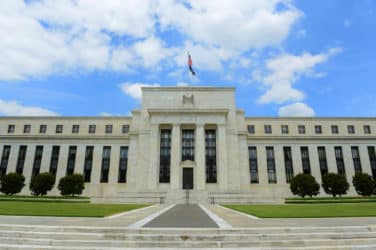Whew!
Traders breathed a huge sigh of relief last week as the markets survived a slew of economic data and the Federal Reserve finally raising short-term interest rates. After spending last week on edge, traders reported the market can now take a breath and relax – allowing investors to take a look at fresh strategies for the third quarter and get trade again.
“We had a lot of data to digest last week, especially the inflation numbers, and they were relatively benign,” said a floor trader in New York. “Inflation look tame and market opinion is that we’re in this very moderate growth/inflation period, which augers well for the market.”
Another trader in Chicago agreed, adding that the current economic picture reminds him of the children’s story Goldilocks.
“With the exception of Trump and his tweets, we’ve got a Goldilocks economy t work here,” the Midwest trader said. “We’re in no danger of overheating at the moment. So the Fed can really engage in a nice gradual tightening of rates without the worry of fast inflation or growth upsetting its plans.”
Trading last week signaled a type of relief trade as volume jumped back above the 7 billion share per day level not seen in over a month, as well as the fact Friday was quadruple witching day. Approximately 7.37 billion shares per day changed hands last week compared to the week prior when volume was 6.45 billion shares per day, according to Bats Global Markets.

Sharon Stark, Incapital
To recap, the Federal Open Market Committee (FOMC) raised the target Fed Funds rate to 1.00 to 1.25 percent, despite the recent deceleration in inflation and expectations that the 12-month rate will remain below the target 2.0 percent. According to Sharon Stark, managing director of fixed income at Incapital, policy makers cited a falling jobless rate and recent advance in household spending as fuel to allow inflation to rise.
“Current monetary policy is characterized as accommodative to allow for continued strengthening in labor markets, which hopefully inspires higher inflation,” Stark said.
What was of more surprise to her was the release of some details regarding the size of balance sheet adjustments to reduce the Fed’s $4.5 trillion in holdings. She noted the announcement was vague with regard to the timing and target balance of reserves.
“According to the Fed, when the FOMC agrees to reduce its holdings of securities, it will do so by cutting the reinvestment of maturing Treasury securities principal proceeds by $6 billion per month initially, then increasing the amount in steps of $6 billion each quarter over 12 months to a total of $30 billion per month,” she said. “The Fed will continue to trim the deployment of maturity proceeds by $30 billion per month until it is determined that the level of reserves is appropriate given the demand by banks.”
So when is the next hike in rates?
According to the eurodollar futures market, the next interest-rate increase looks to be likely in December. The Fed will likely sit out the summer and wait until the November election season is over, one trader explained.
“Traders have been favoring September contracts over December ones, banking on a steepening spread,” he said.
In other news, the Wall Street Journal reported that newly public companies, eager to take advantage of rising U.S. stock prices, are returning to the market faster than ever to sell additional shares. It is the latest sign that public markets have regained appeal for companies and their owners after the slowest year for initial public offerings in more than a decade. Major U.S. stock indexes are hitting records, volatility has been low and shares of companies that have launched IPOs recently have generally performed well—fertile conditions for selling more stock.
The average number of days between a company’s IPO and its next stock sale, also called a follow-on offering, is on pace for a record low this year, according to Dealogic data through Thursday that goes back to 1995. U.S.-listed companies launching their first stock sales in 2017 are doing so roughly 500 days after their IPOs, the data show, compared with an average of more than 900 days since the start of the data.
Also, Virtu Financial is getting a new Chairman. And that Chairman is Robert Greifeld. The former CEO of exchange operator Nasdaq is set to assume command at Virtu once its $1.4 billion acquisition of KCG Holdings in completed, according to a regulatory filing dated May 31.
Greifeld, along with Silver Lake co-founder Glenn Hutchins, joined forces with Singapore’s GIC and Temasek and Canada’s Public Sector Pension Investment Board to buy a combined $750 million of new Virtu stock as part of the firm’s deal to buy KCG. Hutchins will also join Virtu’s board.
Lastly, exchange-traded funds (ETFs) continue their meteoric rise and usage among investors and after just two months into the second quarter, ETF flows are on pace to top $100 billion for the third straight quarter. Both equity and fixed income ETFs have attracted over $20 billion in cash and $10.7 billion, respectively in May, according to the most recent U.S. ETF Flash Flows report from State Street Global Advisors.
SSGA noted in the report that equity ETFs have now recorded seven consecutive months with over $20 billion of inflows.
“2017 continues to be a banner year for ETFs,” began Matthew Bartolini, Head of SPDR Americas Research at SSGA. “First quarter flows notched a new all-time high, and now two months into Q2, flows are on pace to top $100 billion for the third straight quarter. From a headline perspective, it may look as if equity ETFs are the key cog in this well-oiled machine.”
In looking deeper into the numbers, Bartolini noted that while impressive, the $20 billion of flows amassed over the last month would have been halved, if it were not for the $10 billion plus of ETF inflows that occurred in the last five days of May. And while this $10 billion was deposited into equities over the final days of the month, U.S. focused funds were the beneficiary of 99% of that total.
This Week’s U.S. Economic Indicators of Interest:
| Monday | Bill Dudley Speaks
Charles Evans Speaks |
| Tuesday | Redbook Retail Sales
Current Account Stanley Fischer Speaks Eric Rosengren Speaks Robert Kaplan Speaks |
| Wednesday | Existing Home Sales |
| Thursday | Jobless Claims
Leading Indicators Kansas City Fed Mfg Survey |
| Friday | PMI Flash
New Home Sales James Bullard Speaks Loretta Mester Speaks
|






